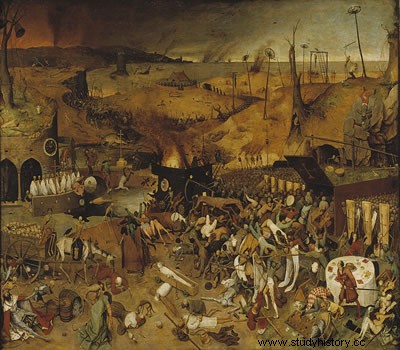(Fatec-SP) The dissolution of feudalism was hastened, at the end of the Middle Ages, by a succession of events that generated the so-called “crisis of the 14th century”. Among these events, it is correct to cite:
- Epidemics, such as the Black Death, originated mainly from the lack of structures in cities to support the population increase and face the problem of hunger.
- Great Famine, manifested in this century, due to the great number of plagues that destroyed the plantations.
- The Hundred Years' War, involving France and Spain on the one hand and England and Portugal on the other, which resulted in countless deaths.
- Peasant Revolt; these, having nothing to eat, abandoned the fields and caused many deaths in the cities.
- Epidemics, such as the Bubonic Plague, which killed about 2/3 of the entire population of Europe.
(Uerj) “I affirm, therefore, that we had already reached the very full year of the Incarnation of the Son of God, 1348, when, in the most exalted city of Florence, whose beauty surpasses that of any other in Italy, the deadly pestilence came.”
BOCCACIO, Giovanni. Decameron . São Paulo:Book Circle, 1991.
In the 14th century, Europe experienced a crisis, marked by the triad “war, plague and famine”. However, this crisis created conditions for countless transformations.
As an example of these transformations, which took place from the 15th century onwards, we can mention:
- increased population density, determining the growth of food production.
- reinforcement of bonds of servitude, causing the migration of inhabitants from cities to the countryside.
- beginning of the process of maritime expansion, strengthening the monarchies in the process of centralization.
- reopening of the Mediterranean Sea, promoting the growth of more dynamic economic relations.
The so-called crisis of the 14th century represented the end of feudalism in Western Europe, being marked by three main events, which are:
- Hundred Years War, jacqueries and Great Famine.
- Crusades, opening of the Mediterranean and Black Death.
- Great Famine, Crusades and Black Death.
- Black Death, Peasant Revolts and the Great Famine.
- Hundred Years War, Crusades and opening of the Mediterranean.
About the 14th century Crisis, it is incorrect affirm:
- that in regions of Belgium, France and England, peasants were involved in great revolts that became known by the name of “jacqueries”.
- that the last decades of the medieval period were marked by wars, centralization of political power and reorganization of economic activities.
- that fearing food shortages – which in fact happened – several nobles facilitated the departure of the serfs from their properties, intending to exchange them for salaried workers.
- in a short time, thousands of Europeans were decimated by a terrible epidemic that spread thanks to the poor hygiene conditions of that time.
Look at the image below:

Triumph of Death, by Pieter Bruegel the Elder (1526/1530-1569).*
The name of the canvas is Triumph of Death and it was made by Pieter Bruegel, in 1562. On the canvas, it is possible to perceive how one of the events related to the so-called Crisis of the 14th century marked the imagination of the time. What was the event depicted on the screen?
- Great Famine.
- Hundred Years War.
- Peasant Revolts.
- Black Death.
*Image Credit:Prado Museum.
answers Question 1Letter E . The others are incorrect for the following reasons:a) the problem to be tackled was not population growth, but the lack of sanitary infrastructure, which contributed to the spread of diseases; b) the reasons would be more climatic than due to pests; c) involved only France and England; d) the rebellious peasants did not abandon the countryside.
question 2Letter C . Maritime expansion strengthened after the 15th century, guaranteeing new sources of wealth to the emerging monarchies.
question 3Letter D . The main events that characterized the crisis of the 14th century are the three, still known as the triad “war, famine and plague”.
question 4Letter C. Concerns about the decline in agricultural production led landowners to prevent serfs from leaving so that they could work in the fields.
question 5Letter D . The canvas seeks to portray the Black Death and how death spread through European society at the time. It is possible to perceive death, represented by skeletons, dragging countless people and corpses, in addition to the despair of the escape of countless of these people.
